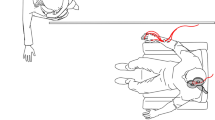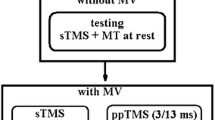Abstract
Transcranial magnetic stimulation was used to evaluate changes in motor cortex excitability after rapid repetitive movements in five healthy subjects aged 23–30 years, by considering the amplitude of motor evoked potentials (MEPs) at rest and after one minute of maximal frequency repetitive abduction-adduction movements of the thumb. In addition, M and F waves were evaluated by stimulating the median nerve at the wrist. All of the examined subjects showed a clear modification in post-exercise MEP amplitudes, with a mean maximal reduction of 50–60% in comparison with basal values and complete recovery after a period of about 35 minutes. The time course of this phenomenon showed a triphasic pattern: (I) a rapid decrease phase up to the fifth minute; (II) a maximal depression phase for a period of about ten minutes; (III) a slow return to basal values. No significant changes were observed in post-exercise M and F waves.
These results show the existence of a reversible modulation of the excitability of the upper motor neuron after rapid repetitive movements. It is likely that this modulation takes place at the level of the motor cortex and that its anatomofunctional substrate is represented by the activation of inhibitory intracortical circuits.
Sommario
Abbiamo valutato mediante Stimolazione Magnetica Transcranica eventuali modificazioni dell'eccitabilità della corteccia motoria dopo movimenti rapidi ripetitivi. Sono stati studiati 5 soggetti sani di età compresa tra i 23 e 30 anni valutando l'ampiezza del potenziale evocato motorio (PEM) a riposo e dopo movimento ripetitivo di abduzione-adduzione del pollice sostenuto per 1 minuto a frequenza massimale. Sono stati inoltre valutati l'onda M e l'onda F da stimolazione del nervo mediano al polso. In tutti i soggetti esaminati è stata riscontrata una chiara modificazione dell' ampiezza del PEM dopo esercizio con una riduzione media massimale del 50–60% rispetto le condizioni basali e recupero completo entro 35 minuti circa. La sequenza temporale di questo fenomeno aveva un andamento trifasico: (1) rapido decremento entro il 5° minuto, (II) depressione massimale della durata di 10 min circa, (III) lento ritorno ai valori basali. Non sono state invece riscontrate modificazioni dell'onda M e dell'onda F.
I dati ottenuti dimostrano l'esistenza di una modulazione reversibile dell'eccitabilità del I neurone di moto dopo movimenti rapidi ripetitivi. È verosimile che tale modulazione si realizzi a livello della corteccia motoria e che abbia come substrato anatomo-funzionale l'attivazione di circuiti intracorticali inibitori.
Similar content being viewed by others
References
Brasil-Neto J.P., Cohen L.G., Pascual-Leone A., Jabir F.K., Wall R.T., Hallet M.:Rapid reversible modulation of human motor output after transient deafferentation of the forearm: a study with transcranial magnetic stimulation. Neurology 42:1302–1306, 1992.
Brasil-Neto J.P., Leone A.P., Valls-Solè J., Cammarota A., Cohen L.G., Hallett M.:Postexercise depression of motor evoked potentials: a measure of central nervous system fatigue. Exp. Brain Res. 93:181–184, 1993.
Cohen L.G., Bandinelli S., Findley T.W., Hallett M.:Motor reorganization after upper limb amputation in man. Brain 114:615–627, 1991.
Donoghue J.P., Sanes J.N.:Organization of adult motor cortex representation patterns following neonatal nerve injury in rats. J. Neuroscience 8:3221–3232, 1988.
Donoghue J.P., Suner S., Sanes J.N.:Dynamic organization of primary motor cortex output to target muscles in adults rats: II. Rapid reorganization following motor nerve lesions. Exp. Brain Res. 79:492–503, 1990.
Kiers L., Cros D., Chiappa K.H., Fang J.:Variability of motor potentials evoked by transcranial magnetic stimulations.Electroencephalogr. Clin. Neurophysiol. 89:415–423, 1993.
Jacobs K.M., Donoghue J.P.:Reshaping the cortical motor map by unmasking latent intracortical connections. Science 251:944–947, 1991.
Sanes J.N., Suner S., Donoghue J.P.:Dynamic organization of primary motor cortex output to target muscles in adult rats: I. Long-term patterns of reorganization following motor or mixed peripheral nerve lesions. Exp. Brain Res. 79:479–491, 1990.
Author information
Authors and Affiliations
Rights and permissions
About this article
Cite this article
Bonato, C., Zanette, G., Polo, A. et al. Cortical output modulation after rapid repetitive movements. Ital J Neuro Sci 15, 489–494 (1994). https://doi.org/10.1007/BF02334610
Received:
Accepted:
Issue Date:
DOI: https://doi.org/10.1007/BF02334610




